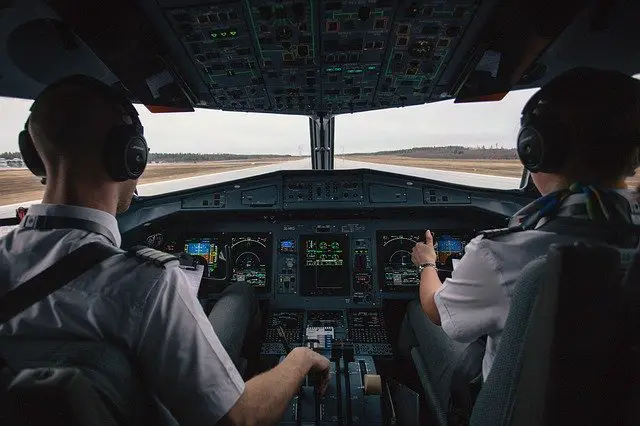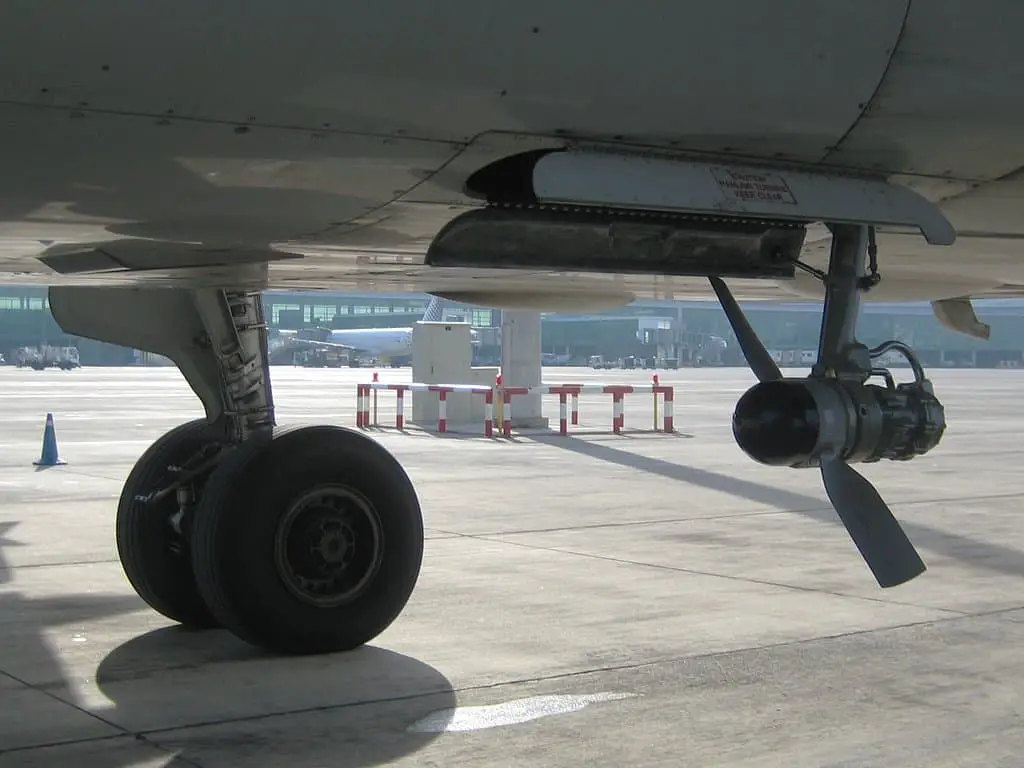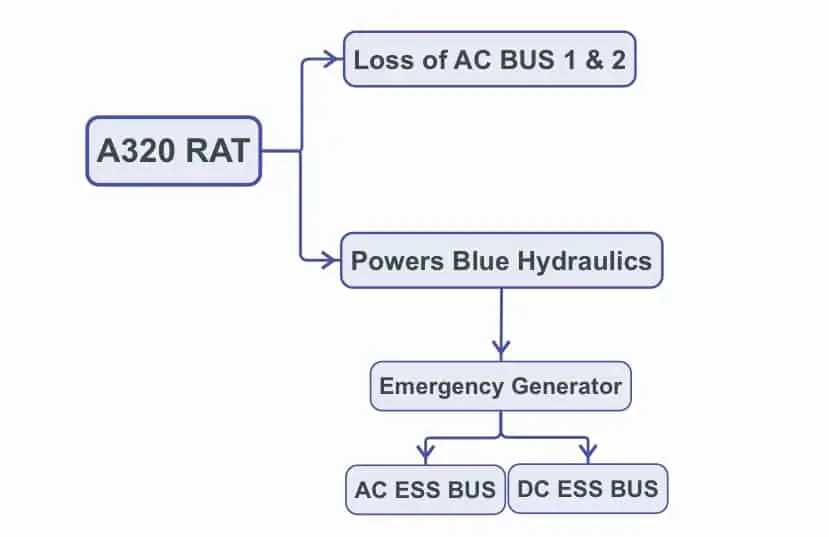I may earn a small commission from links on this page, but I only recommend quality products I trust.

Pete has been flying aircraft for the last 20 years. He has flown everything from light piston aircraft up to heavy jets as both First Officer and Captain. He’s currently enjoying life flying the Airbus A330 for a major international airline.
The A320 Ram Air Turbine (RAT) is an amazing piece of technology that has saved lives. The RAT on the Airbus A320 is a small propellor that will deploy in a serious emergency to supply emergency electrical power to the aircraft.

Table of Contents
When does the RAT deploy on the A320?
The role of the Ram Air Turbine on the Airbus A320 is to act as an electrical backup in the event of a serious emergency.
The RAT can be deploy either automatically, or manually when selected by the pilots.
The A320 RAT automatically deploys when the following conditions are met:
- AC BUS 1 not electrically powered
- AC BUS 2 not electrically powered
- Aircraft speed greater than 100 kt
Note in the case of automatic deployment, the emergency generator (EMER GEN) will be connected to the aircraft electrical system as soon as its parameters are within limits.
As soon as the emergency generator electrical parameters are within tolerance the emergency generator is connected to the aircraft network.
Airbus A320 Flight Crew Operating Manual
If the pilots decide to manually deploy the RAT (this could be in response to an ECAM or while following a QRH procedure) they will select the “RAT MAN ON” pushbutton on the overhead panel.
The RAT MAN ON pushbutton (located on the “EMER ELRC PWR” section of the overhead panel on the A320) will deploy the RAT manually.
Note however in this case, the emergency generator is connected to the aircraft’s electrical circuit 3 seconds after the RAT supplies the emergency generator.
Emergency generator coupling occurs 3 s after the RAT supplies the emergency generator.
Airbus A320 Flight Crew Operating Manual
Guarded Switches: The RAT MAN ON pushbutton is a “guarded switch” i.e. the switch is covered by a red tab that has to be moved aside before pressing the relevant button. As per Airbus SOP’s, guarded switches require both pilots to confirm the button is correct before it is pressed.
As stated above, the emergency generator (EMER GEN) will supply the aircraft electrical system with, or without, a delay depending on the circumstance.
Note that RAT extension and coupling to the EMER GEN takes approximately 8 seconds. During this time the batteries power the emergency generation network.
During RAT extension and emergency generator coupling (about 8 s), the batteries power the emergency generation network.
Airbus A320 Flight Crew Operating Manual (DSC-24-10-30-30)


The 5 Best Aviation Audiobooks (Chosen by a Pilot) A list of the best aviation audiobooks chosen by a current airline pilot. From fascinating stories at the dawn of aviation to modern day aircraft accidents.
How does the RAT work on the Airbus A320?
The Ram Air Turbine (RAT) installed on the A320 is coupled to a hydraulic pump that allows the blue hydraulic system to be pressurized even if both engines fail or electrical power is lost.
The blue hydraulic circuit (A320) drives the emergency generator, or “EMER GEN”.
Related Reading: A Guide to the Airbus A320 Hydraulic System
ELEC EMER – Emergency Electrical Configuration (A320)
ELEC EMER (as it is referred to by the ECAM procedure) is triggered by the loss of all main generators (Engine 1, Engine 2 and the Auxiliary Power Unit APU) which causes the loss of AC 1 and AC 2 busbars.
This cockpit workload for the pilots will increase significantly. There will be multiple ECAM warnings and QRH procedures to reference.
Most of the displays will be lost and the pilot in the left seat will fly the aircraft manually while the right-seat pilot troubleshoots the problem and provides assistance to the PF (Pilot Flying).
Multiple systems will be downgraded or lost completely, and the pilots can refer to the ELEC EMER CONFIG SYS REMAINING in the QRH (Quick Reference Handbook) for a list of the remaining systems.

Systems Remaining in Emergency Electrical Configuration (ELEC EMER)
Although the loss of all main generators leading to ELEC EMER is highly unlikely, the system is designed with safety in mind. Even in this serious situation the aircraft will be flyable.
There are a number of systems remaining to allow the fly the aircraft, to navigate to a safe landing and to communicate with air traffic control (AVIATE – NAVIGATE – COMMUNICATE).
The pilots will declare a MAYDAY and operate the aircraft with the following systems:
| Fly | PFD 1 using Alternate Law |
| Navigate | ND 1, FMGC 1, RMP 1, VOR 1/ILS 1, DME 1 |
| Communicate | VHF 1, HF 1, ATC 1 |
The RAT is turned by the airflow and below 125 kt it will stall, and thus the emergency generator will no longer be powered.
For this reason the QRH (Quick Reference Handbook) and the ECAM procedure state the approach to landing must be flown at a speed of at least 140kt to ensure the electrical system remains powered by the EMER GEN.
Emergency Electrical Generator (EMER GEN)
The Emergency Generator is an electrical generator that is turned by hydraulic power. On the Airbus A320 the emergency generator will supply the essential AC and essential DC busbars with electrical power.
Busbars are a way of grouping electrical components together. The Airbus A320 has 9 main busbars – some of which are supplied with AC electrical power, and some with DC power.
After the loss of all main generators (engine 1 & 2, and the APU), and with the aircraft speed above 100kt, the RAT will deploy automatically, powering the blue hydraulic system which in turn drives the emergency generator.
The EMER GEN will supply 5 KVA of three-phase 115 volt and 200 volt 400 HZ electricity. DC power is supplied to the ESS DC busbar by the ESS TR (Essential Transformer Rectifier )
Once deployed, the RAT cannot be restowed in the air – it can only be restowed by a maintenance crew on the ground.

The 5 Best Aviation Audiobooks (Chosen by a Pilot) A list of the best aviation audiobooks chosen by a current airline pilot. From fascinating stories at the dawn of aviation to modern day aircraft accidents.
Further Reading
For more on how the RAT is used on different aircraft, including real world examples of its use, take a look at these pages:
A Guide: The Ram Air Turbine on Aircraft
What Happens When Aircraft Run Out of Fuel (3 Examples)
Aircraft Hydraulic Systems – A Pilot’s Guide
A Guide to the A330 Hydraulic System
A Guide to the A320 Hydraulic System
Airbus – Safety First Publication
Video: Airbus A320 RAT Deployed
Here is a video example showing a Spirit Airlines with the Ram Air Turbine deployed. The RAT is visible on the left hand side under the fuselage as the aircraft makes its approach to landing.
A320 RAT Summary (FAQ)
What does the Ram Air Turbine (RAT) do on the Airbus A320?
The Ram Air Turbine, or RAT, on the A320 is a backup electrical system. In the event of dual engine failure, or a serious electrical problem, the RAT will deploy. The RAT is a small propellor connected to a hydraulic pump and emergency electrical generator which will restore limit electrical power to the aircraft.
What is Airbus ELEC EMER?
ELEC EMER (Emergency Electrical) configuration occurs when all the main electrical generators (engine 1 & 2, and the APU) are unavailable. In ELEC EMER the only electrical power available is from the Emergency Generator (EMER GEN) which is powered by the Ram Air Turbine (RAT).
What are guarded switches on Airbus aircraft?
Guarded switches are covered by a spring loaded cover that must be moved to the side to activate the switch. In Airbus SOP’s, both pilots must confirm guarded switches are correct before they are operated.
If you found this article interesting please take 5 seconds to share this on your favorite social media. Thanks so much, I really appreciate it! [email protected]

Pete has been flying aircraft for the last 20 years. He has flown everything from light piston aircraft up to heavy jets as both First Officer and Captain. He’s currently enjoying life flying the Airbus A330 for a major international airline.






